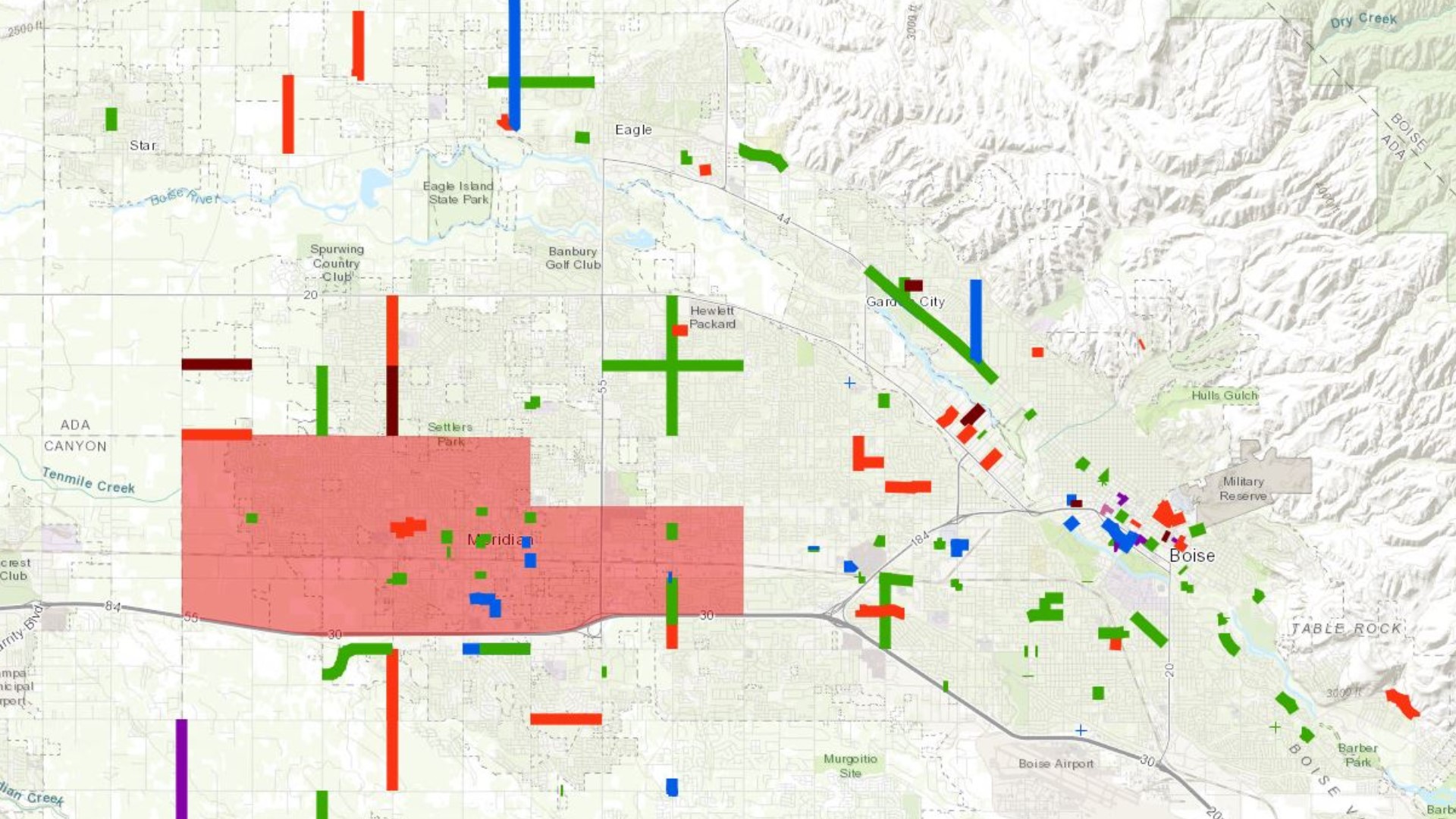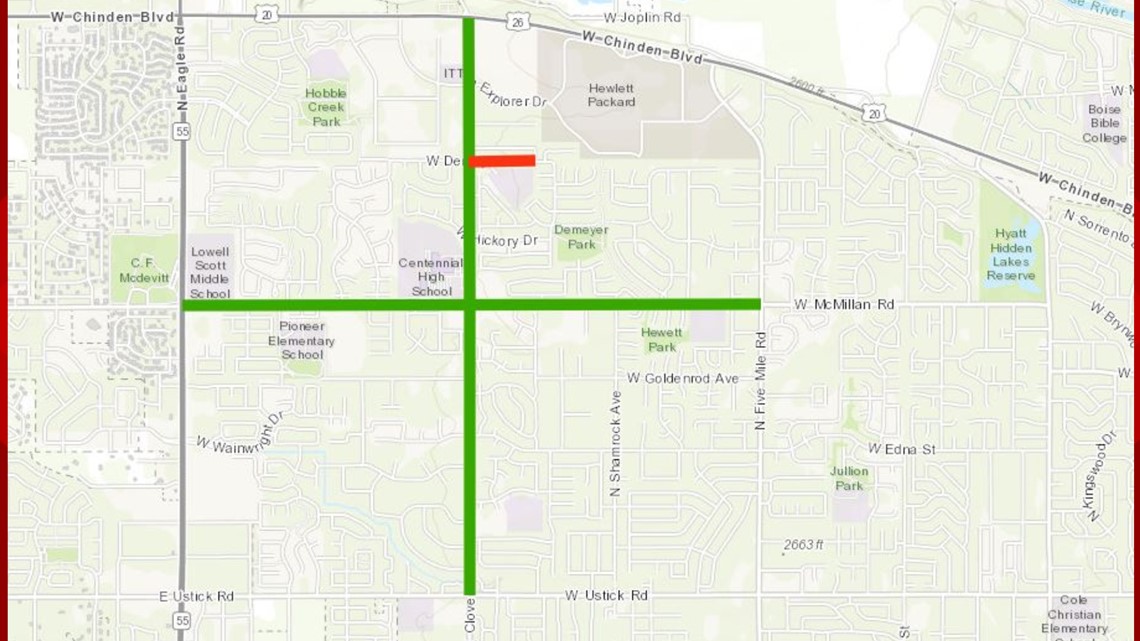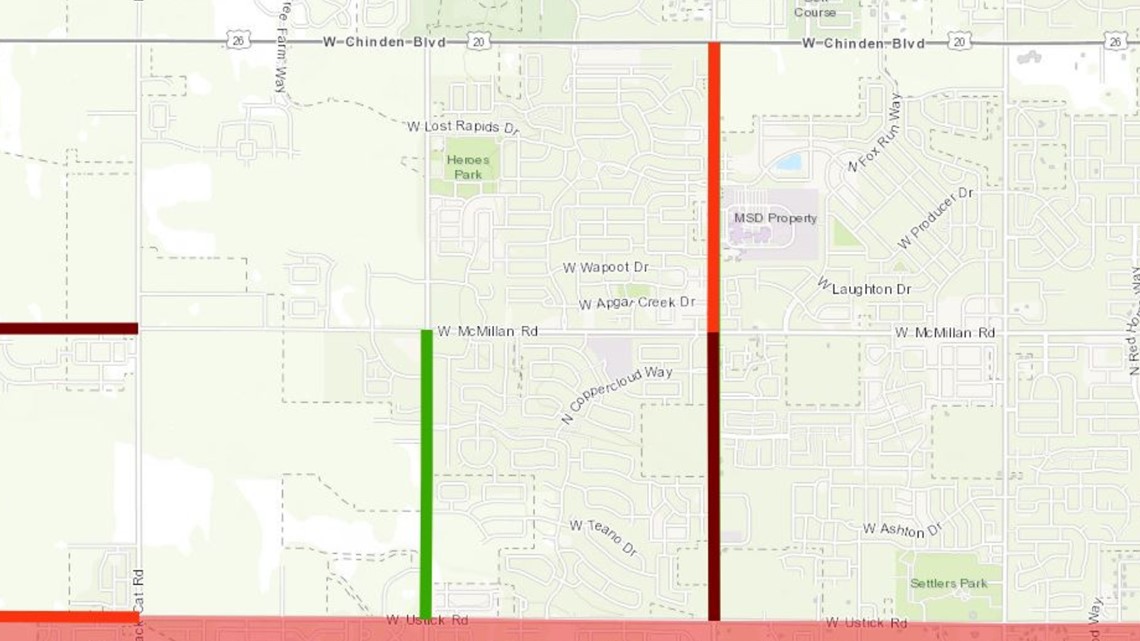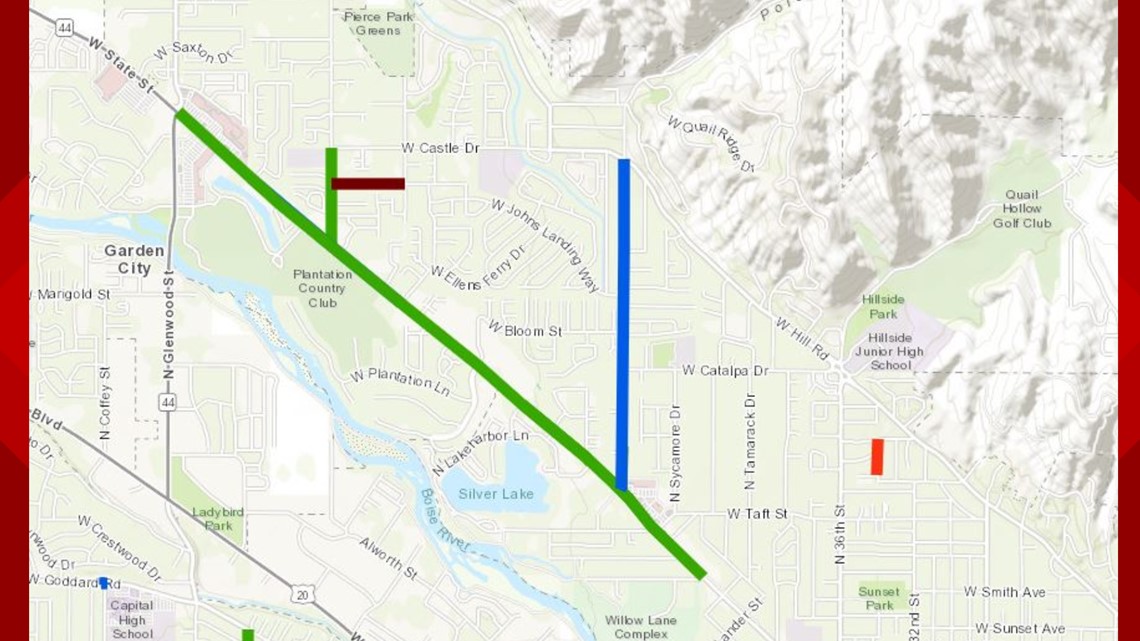What could ease the Treasure Valley's traffic congestion?
From widening roads to making some areas safer for bikes, see what officials are tackling in 2019 as Boise continues to grow.
ACHD

Boise and rest of the booming Treasure Valley are growing so rapidly that traffic planners briefly considered expanding State Street to nine lanes.
But, to the relief of some, adding a California freeway-like amount of lanes to one of the Treasure Valley's main thoroughfares — which currently mostly ranges from 4 to 5 lanes — isn't currently an Ada County Highway District (ACHD) plan.
"That really wasn't what the community wanted," said Ryan Head, the ACHD planning and programs supervisor.
So what does the community want?
Managing the valley's roadways while meeting the growing number of drivers requires a coordinated approach involving multiple agencies. There's plenty of cooperation, but addressing congestion in the Treasure Valley also involves several conflicting viewpoints.
So far, road widening has been ACHD's most common method of easing congestion around the Treasure Valley.
Others advocate for combating traffic in other ways, such as boosting alternative transportation.
Idaho is the only state in the nation that does not fund public transportation, according to a spokesperson with Valley Regional Transit, the Treasure Valley bus service and one of the Treasure Valley's two main public transit options. The lack of state funding inhibits some public transportation projects that would get more cars off the roads, such as Boise Mayor Dave Bieter's circulator project or Valley Regional Transit's long-term vision for an upgraded bus program called ValleyConnect 2.0.
And while small pockets of Boise are especially conducive to cyclists and others getting around without cars, some argue there's much work to be done.
"There are days when I am riding my bike to work, I’m worried because there’s a lot of cars very close to me and it's pretty intimidating," said Cynthia Gibson, the executive director of the Idaho Walk Bike Alliance.
No matter if you've lived in Boise for 10 years or if you're a newcomer to Idaho, it can be hard to dissect the different public transit options in the Treasure Valley.
We decided to take a closer look at what exactly the biggest hurdles and priorities are when it comes to easing traffic congestion in the Treasure Valley.
What are ACHD's big 2019 projects? 'You can't build your way out of congestion'
ACHD has four major road widening projects in the works for 2019, with 300 more that will be designed or built in the next five years, according to Head.
Those four major projects are:
- Widening Cloverdale to five lanes between Ustick Road and Chinden Boulevard. ACHD officials are working jointly with the Idaho Transportation Department on the Cloverdale overpass on Interstate 84.


- Widening Linder Road to five lanes between Ustick Road and Chinden Boulevard.


- Widening the Cole Road and I-84 on/off ramps intersections, which would ease the traffic choke points on Cole Road, according to Head.
Their other main project is the widening of State Street and Collister Drive, which followed the expansion of the State Street and Veterans Memorial Parkway intersection last year.
WATCH BELOW: Construction at State and Collister causing headaches for drivers, businesses
Widening those State Street intersections will help with congestion and improve Valley Regional Transit's route, but the ACHD's plans are still short of what their forecasts and models (provided by the Community Planning Association of Southwest Idaho), show what was needed to keep up with growth.
TRENDING: Do Californians feel welcomed in Idaho?


In fact, the Treasure Valley could eventually reach a tipping point where it won't be possible to build more roads to alleviate traffic snarls, according to Head.
"You can't build your way out of congestion and at some point, we just have to manage it whatever means we can," he said.
You can see ACHD's Road Work map here.
Alternatives to road widening Community organizers disagree over the best way to ease congestion
Gibson, the executive director of the Idaho Walk Bike Alliance, is critical of ACHD's road-widening focus, arguing that continuing to widen roads creates new hurdles for pedestrians, cyclists and bus routes.
"Widening roads to accommodate cars is very expensive and it is very dangerous for people out walking and riding their bikes," Gibson said. "You have to always consider other modes (of transportation) because when you build roads just for cars, that’s exactly what you get – you get more cars."
Don Kostelec, the vice president of the Idaho Walk Bike Alliance, worked at ACHD from 2002 to 2008 and said, in retrospect, he could have done more to steer the agency towards better use of land during early growth planning.
“It’s kind of has been our national policy perspective on transportation for 60 years, everything from our federal transportation funding has been incentivized for widening roads," he said.
Kostelec also argues that widening roads doesn't help reduce commuting times or congestion, which continue to steadily grow.
Between 2000 and 2014, "the annual hours of congestion per auto commuter in Ada County rose from 28 hours to 37 hours, or 33 percent," Kolstelec said.
The annual congestion cost per auto commuter, how much fuel and car maintenance cost drivers during their commutes, in Ada County rose from $500 a year to more than $800 a year when delay hours and costs were growing.
WATCH NOW: Boise construction zone tricky for people with disabilities
In 2017, 38 pedestrians were killed by vehicles in Idaho, including 6 that were 15 years old or younger, according to the Governors Highway Safety Association.
Gibson said city planners should design more roadways with the most vulnerable people in mind, such as those in wheelchairs. There are already great examples in Boise, she said, including downtown, Hyde Park and Central Addition.
ACHD planners have shown they are receptive to the road-widening opposition and community feedback on any road project, such as backing off those plans for 9-lane State Street that the community and the highway district weren't fond of.
"We always encourage and invite the public to take part in the decisions that we make and planning," Natalie Shaver, a spokesperson for ACHD, said.
Shaver says that people can voice their opinions through the planning process on single projects or long-term plans during public meetings if they have any concerns or criticisms.
The City of Boise does have a plan to make roadways safer for bicyclists and pedestrians with the Transportation Action Plan.
Mike Journee, a spokesperson for the City of Boise, says the plan is just a "philosophy of how we want our city streets to look like at some point in the future."
The plan would narrow roads to reduce the number of drivers that speed, improve crosswalks, add protected bike lanes, plan medians with trees, and add chicanes (slight turns on a straight road to slow vehicles) in neighborhood streets.
Putting the plan into action requires cooperation with ACHD since the Highway Department has control over the valley's roads and the city only owns and controls a few streets in downtown Boise, which is a challenge for the city, Journee says, since the city has to separate its land use and development plans from how it wants its streets to be designed.
The Transportation Action Plan has no set date to be completed but is something that the city and ACHD use as a lens for the two groups to look through when planning out roadwork, according to Journee.
While Boise does have a long-term vision for how streets are planned in the city, they can only nudge and suggest to ACHD how to plan their projects.
RELATED: Where the Sidewalk Ends | Hazards for pedestrians, cyclists at one of Boise's busiest intersections
WATCH NOW: Where the Sidewalk Ends: Pedestrians and cyclists face hazards at one of Boise's busiest intersections
Funding public transportation in Idaho 'We're actually the only state that doesn't get any state funding for public transportation'
Idaho has a unique hurdle when it comes to expanding car alternatives - funding.
“We’re actually the only state that doesn’t get any state funding for public transportation," said Mark Carnopis, the spokesperson for Valley Regional Transit (VRT).
The region's other main public transit option is ACHD's Commuteride, which offers van and carpooling services.
Both VRT and Commuteride face their own challenges when attempting to address traffic and congestion in the area, but both are trying to get more cars off the roads.
"If we can reduce the number of single occupant vehicles on the road, I think everyone will be happy," Carnopis said.
Maureen Gresham, the manager for Commuteride, said their "Smart Commutes" program helps commuters find alternatives such as vanpool services, carpools, walking, biking, and the bus system.
In 2018, there were over 125,000 Smart Commutes that reduced vehicle miles traveled by 560,000 miles, according to Gresham.
However, Commuteride's vanpool service numbers have been stable over the last few years while the Treasure Valley's population continues to grow.
According to Commuteride documents, their efforts take 700 cars off of the roads every workday through Smart Commutes. In comparison, 33,591 people drove on Fairview Avenue near Eagle Road in one day in 2017.
While over 50 percent of Commuteride's funds come from fares, VRT relies on federal grants on spending, a flat funding source that limits how much they can do to expand or cope with growth, according to VRT officials.
Carnopis says that local taxes, such as a city-wide sales tax, could go a long way towards putting VRT's ValleyConnect 2.0 plan into place.
The state legislature has been slow to address their funding concerns or to explore other state-wide taxing options, Carnopis says.
"There’s been reluctance in the past to give cities and counties the ability to ask voters to approve a local ballot referendum for local funding," he said. "We would definitely need enabling legislation that would allow cities and counties to ask voters for a local taxing option, which would include a local sales tax.”
VRT has two other main funding sources, city membership dues as well as revenue from fares and advertising - which makes up less 10 percent of their operations budget, Carnopis says.
However, the lack of funding keeps VRT moving forward and getting creative with more options. They recently started to work with Lyft, the ridesharing platform, to help bring more people to certain bus stops around Boise.
Boise's Transportation Action Plan does highlight the three main VRT routes in Boise with the potential to serve the most people. The three routes would all connect in downtown Boise and major hubs around the city - the Boise Airport, Boise Townsquare Mall and the intersection State Street and Gary Lane.
The plan labels these routes as 'Best-in-Class' and would be used to attract more rides and show that the bus system can be 'safe, convenient and enjoyable.'
Commuteride also has four major initiatives planned to roll out in 2019, but time will tell if any new public transportation programs will be able to make a dent in the Treasure Valley's traffic woes.
To help traffic and congestion, Kolstelec encourages more collaboration between ACHD, ITD, the state legislature and Valley Ride to offer better public transportation options to people in the Treasure Valley.
WATCH NOW: Growing Idaho: Impact on transportation
